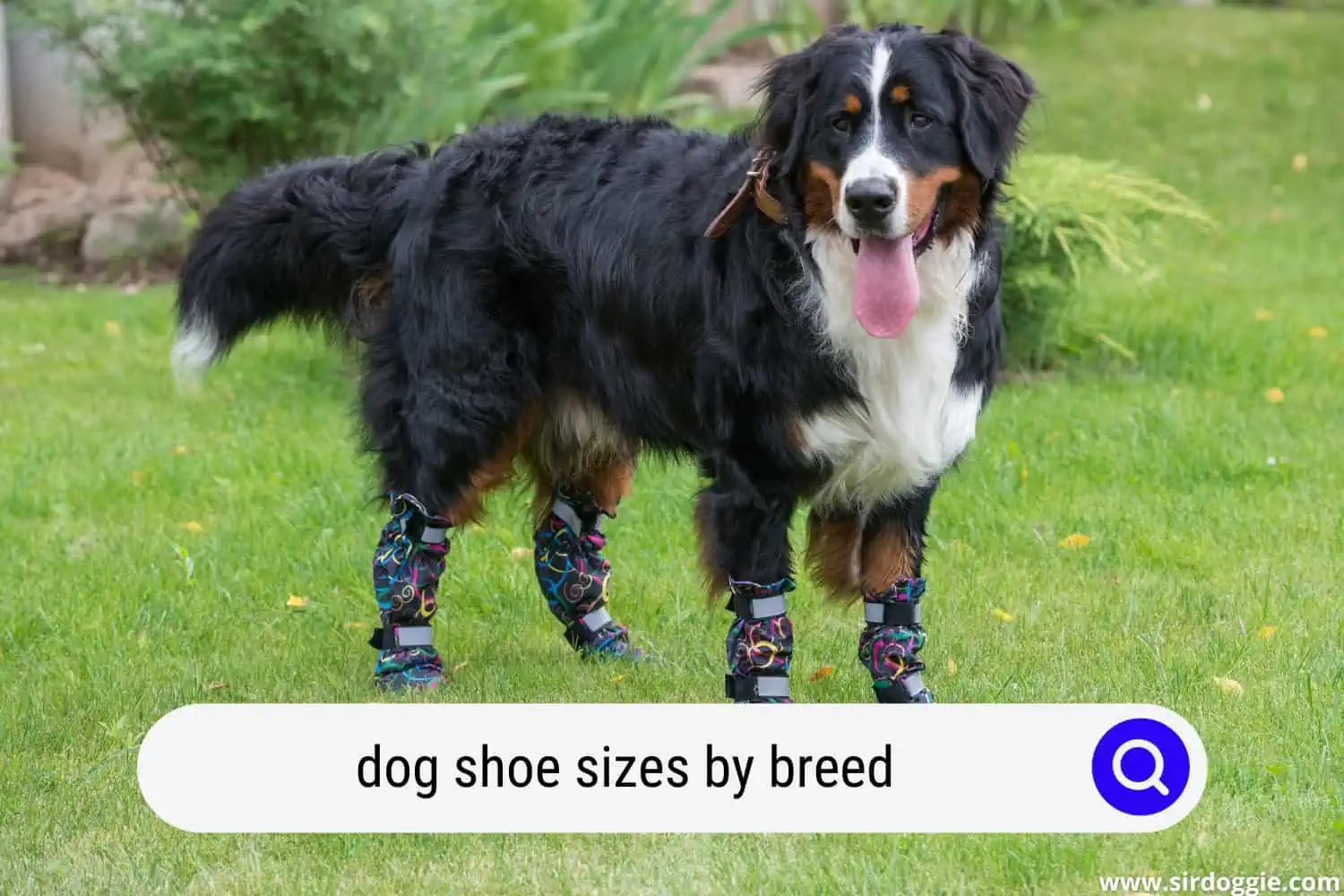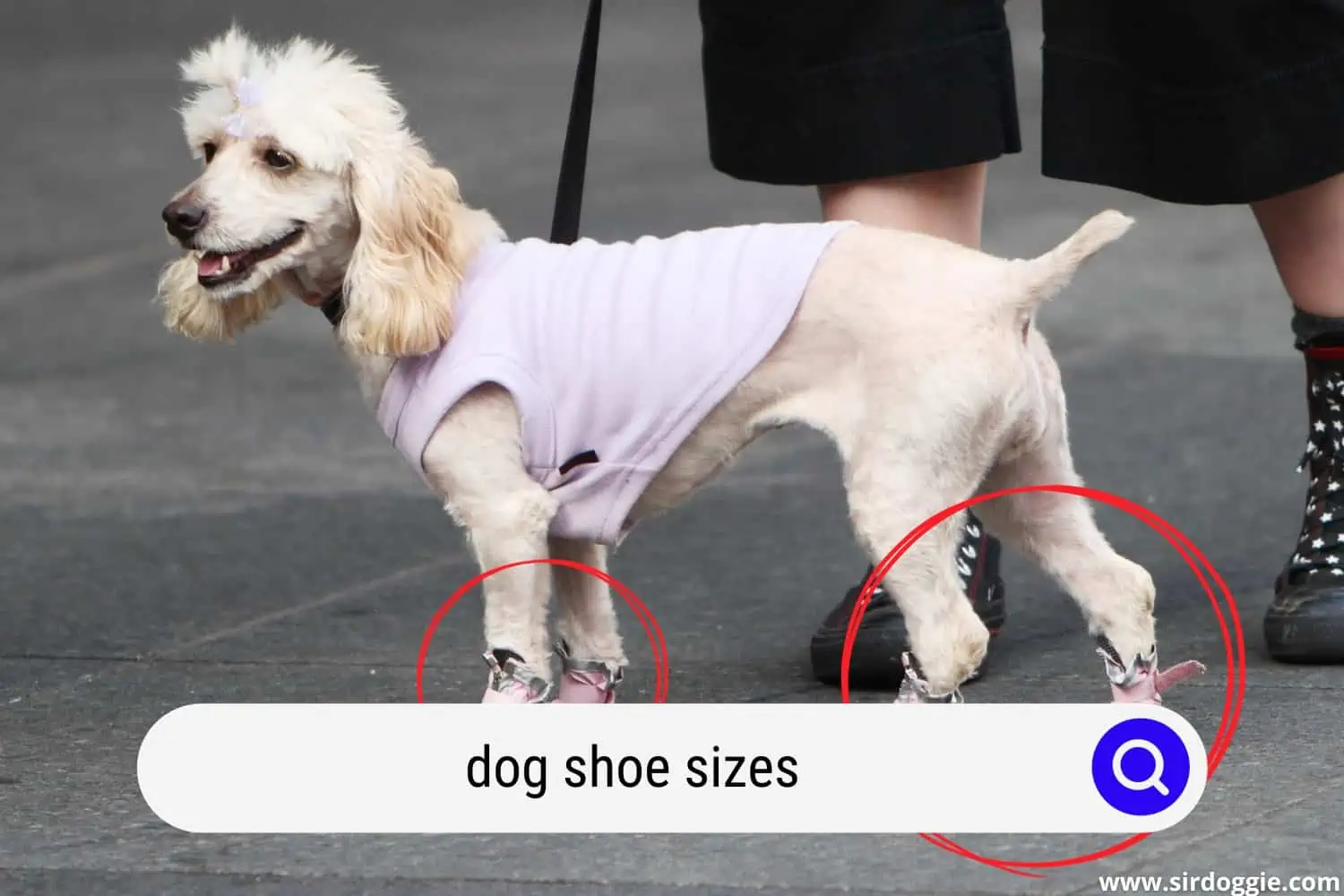Dog Shoe Size By Breed Is Not An Exact Science
Dog shoe size by breed can and has been calculated and laid out. It is not an exact science, however. Within a breed, a dog’s paw size can vary, although it will not vary by a lot. This article will attempt to give you an overview of what various shoe sizes might fit various breeds.

Dog Boot Sizes
There is a lot of variety in dog boot sizes, from a teacup Chin to a Bernese Mountain Dog and everything in between. Dog shoe size by breed is the best place to start if you have a pure-bred dog. If you do not have a purebred dog, then you will definitely want to measure your dog’s paws. It’s a good idea to measure even if you have a pure-bred dog with what looks to be average paw sizes for the breed.
For instance, you can fairly expect all the chihuahuas to have a similar paw size that is substantially smaller than a Newfoundland. At the same time don’t judge by the size of the dog. The Great Dane, though seeming to be one of the largest breeds has paws that are substantially smaller than a St. Bernard.
Related Reading: Clothes For Pugs and Accessories: Canine Passion For Fashion
Dog Feet Sizes
The build and weight of the dog are also very important. Just because a dog is tall and well-built does not mean his paws will be larger than a shorter, stockier dog like the mountain dog. Weight and overall distribution of weight are probably the most critical factors in the size of a dog’s paws.
However, for the most part with purebred dogs, you can judge the size a puppy will grow to be by looking at the size of their puppy paws. A chihuahua pup will have small paws while the Great Pyrenees will have very large paws at 7-8 weeks of age.
You can quantify the size of a dog’s paws using numbers like 1-10 with one being large. A chart could say things like xx-small to xxx-large based on how many different sizes a manufacturer makes for dog shoes.
Puppy Paw Size Charts
As mentioned previously, you can tell a lot about the size of your adult purebred dog by measuring its paws at various stages of puppyhood. Don’t get fooled though. Know your breed. A Pembroke Welsh Corgi at 12 weeks old might have almost the same size paws as a 12-week-old St. Bernard, yet their size is substantially different. Because the corgi is a dwarf breed they hold a lot of weight and mass in a short – not small – body. In adulthood, they might weigh 30 pounds, while that St. Bernard will weigh around 100 to 120 pounds.
Still, at 12 weeks you might need the same size dog boot sizes for both these very different breeds. However, by the time you get these two pups to 6-9 months of age, their paw sizes will be very different from each other. You should also remember if you want to put shoes on your puppy that you will have to change sizes at least once if not more times, as they grow.

Two Types Of Dog Shoe Size By Breed Charts
I’m going to talk about two different types of dog shoe sizes by breed chart. There certainly could be more than these two and again it depends upon the manufacturer of the dog boots. These two charts use two different units of measure for their dog shoes. One company uses sizes from extra small to extra large. Another might use a numerical system, for instance defining what breeds fit in each numerical category.
I will talk about the size chart first. Dog shoe size by breed might look something like this:
XXXsmall teacup-sized dogs
XXsmall Chihuahuas, Rat Terriers, the Russels
Xsmall Toy breeds
Small Miniature Poodle, some small terriers like Cairns and Westies, MinPins
Medium Miniature schnauzer, Pekingese, Corgis
Large Chows, Labradors, Doberman Pinscher
Xlarge Great Dane, Wolfhound, most sighthounds
XXlarge St. Bernard, Newfoundland, Great Pyrenees, most Mountain Dogs.
These categories are usually determined by weight but might also be determined by the size of the dog’s paws. Usually, these factors are correlated – paw size and weight. However, they are not always correlated.
Learn more about: My Dog’s Coat Is Changing Color
The second form of chart uses weight as well for dog boot sizes. This chart is somewhat similar in the size of the dog it puts in each category. For instance, this second group is numerical in form perhaps like this:
One – up to three pounds
Two-three to ten pounds
Three – ten to fifteen pounds
Four – fifteen to twenty pounds
Five – twenty to thirty pounds
Six-thirty to forty pounds
Seven – forty to fifty pounds
Eight – fifty to seventy pounds
Nine – seventy to ninety pounds
Ten – one hundred to one hundred twenty pounds
Eleven – dogs over one hundred twenty pounds.
Measuring Dog Feet Size
So how do I go about measuring my dog’s feet size regardless of which type of sizing the boots I buy use? Here’s how to measure your dog’s shoe size by breed. Use large pieces of paper – about the size of packing paper.
Place one piece of paper on the floor and place your dog’s front paw on the paper. Make sure your dog places its full weight on the paw. Mark and measure from the back of the leg (the dog’s heel) to the front of the longest toenail. When you do this make sure your dog’s toenails are clipped to their normal, healthy length.
If you plan to use 4 shoes or boots then repeat this same process for the dog’s rear paw.
Read more about: Why Do Dogs Dig On Beds?
Dog Shoe Size By Breed
For the most part, dog shoe sizes can easily be determined by their breeds. Quite often you won’t need to measure. You can just look up the size designation for your breed regardless of the unit size being used. Just remember as you do this that this correlation between the breed and the shoe size is not always what you expect.
If you own a greyhound you might be surprised by how small their paws are. Compare that to the aforementioned, short corgi with large paws. Don’t make assumptions. Measuring is the safest way to know the exact size you need, knowing weight is also a factor.

Family Dog Expert Author
Hi there! I’m Stuart, a devoted dog lover and family dog expert with over a decade of experience working with our furry companions. My passion for dogs drives me to share my knowledge and expertise, helping families build strong, loving bonds with their four-legged friends. When I’m not writing for SirDoggie, you’ll find me hiking, playing with my beautiful dog, or studying music.